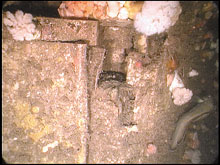
This photo shows the steamship Portland's rudder post, which helped to identify the vessel.
Verifying the Wreck
Provided by the Stellwagen Bank National Marine Sanctuary
The investigation conducted July 27-28, 2002, gathered sufficient evidence to confirm that the wreck suspected to be the Portland is in fact the correct vessel. It is clear that the wreck site consists of the remains of a large side paddlewheel steamship. Ships of this type were almost exclusively used to carry passengers, and the loss of such a vessel would not have gone unreported in the historical record. The Steamship Portland was the only vessel lost in Massachusetts Bay matching the characteristics of the wreck explored by the Stellwagen Bank National Marine Sanctuary and the National Undersea Research Center at the University of Connecticut.
Maritime archaeologists are often confronted with unidentified shipwrecks. While much can be learned from the study of the shipwreck site itself, important information can also be gleaned from linking the sunken vessel to the historical record. Maritime archaeologists make the link by comparing the observed characteristics of the shipwreck to the characteristics of ships known to have sunk in that vicinity. This combination of archival information and imagery can help produce a detailed picture of the vessel's physical construction and its activities, as well as offer insights into how and why it sank.
Prior to beginning the Portland project, personnel from the Stellwagen Bank National Marine Sanctuary conducted archival research by examining books, newspapers, manuscripts, photographs, and paintings that document Massachusetts's maritime history. The information gathered from these sources formed the basis for a list of vessels wrecked in Massachusetts Bay. While the list included many sailing ships, only one large paddlewheel steamship, the Portland, is known to have sunk in the bay.
Further historical research identified particular construction characteristics of the Portland that would enable researchers to make a positive identification of the steamer once the correct wreck was explored and mapped. These characteristics included the steamship's length and breadth (281 ft by 62 ft), its strongly built wooden hull, side paddlewheel construction, and walking beam steam engine.
Sidescan sonar imagery and remotely operated vehicle (ROV) video of the Portland site clearly showed a very large paddlewheel steamship. The sidescan sonar imagery allowed the investigators to measure the vessel's length at 275 ft and its breadth at 64.3 ft (these numbers are within an acceptable range of variation for the equipment and the depth of the subject ship). Overall, the most obvious diagnostic feature was the vessel's paddle guard sponson, which projects out from the hull to protect the paddlewheels and increase room aboard ship.
Some propeller-driven steamers operating in New England during the 20th century also had these guards extending beyond the hull to increase deck space. However, the Portland site's stern area clearly showed only a rudder, instead of a rudder and a propeller. To further corroborate the assessment, the ROV also recorded the slightly less visible paddlewheel flanges. These flanges connected the arms, or spokes, of the paddlewheel to the paddleshaft (the axle). The ROV photographed the vessel's steam escape pipe, with its distinctive spittoon-shaped end, twisted and lying on the sea floor near the wreck, along with other pieces of copper tubing (now oxidized and green in color).
Subsequent trips to the Portland site have produced more detailed sidescan sonar images that clearly show the central A-frame, diamond-shaped walking beam steam engine, and side-by-side dual smokestacks. This combined evidence provides further support to the assertion that the investigated wreck truly is the Portland.

















